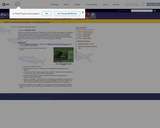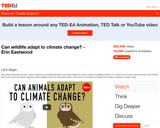
In this simulation activity, students will examine natural selection in a small population of wild rabbits.
- Subject:
- Biology
- Science
- Material Type:
- Activity/Lab
- Provider:
- PBS
- Author:
- WGBH
- Date Added:
- 02/26/2019

In this simulation activity, students will examine natural selection in a small population of wild rabbits.

In this simulation activity, students will collect data, formulate a hypothesis, and run a series of experiments in order to discover the interplay between natural selection and sexual selection in a wild population of guppies.

With this interactive tutorial, students explore the evolutionary adaptation of feathers in birds.

This activity will best fit when teaching about natural selection and how favored alleles lead to change in species. The activity will further this idea by introducing students to the Hardy-Weinberg Theorem, which uses allele frequency to determine if a population is evolving. The activity can be done with the entire class or as part of a differentiated lesson. This lesson was developed by NCDPI as part of the Academically and/or Intellectually Gifted Instructional Resources Project. This lesson plan has been vetted at the state level for standards alignment, AIG focus, and content accuracy.

Students learn about the amazing evolutionary history of arthropods. The module contains informational text, interactives, and assessments.

This online module teaches about natural selection and how bacteria can influence natural selection (antibiotic resistance). Dr. Carl Bergstrom manages evolution. From his laboratory at the University of Washington, Carl figures out how to control the evolutionary future of microbe populations, nudging them towards particular destinies and away from others.

Explore the ideas and evidence that helped Charles Darwin create his theory of evolution.
GeoInquiries are designed to be fast and easy-to-use instructional resources that incorporate advanced web mapping technology. Each 15-minute activity in a collection is intended to be presented by the instructor from a single computer/projector classroom arrangement. No installation, fees, or logins are necessary to use these materials and software.

Explore the ideas and evidence that helped Charles Darwin create his theory of evolution.

In their study of the medium ground finches, evolutionary biologists Peter and Rosemary Grant were able to track the evolution of beak size twice in an amazingly short period of time due to two major droughts that occurred in the 1970s and 1980s. This activity simulates the food availability during these droughts and demonstrates how rapidly natural selection can act when the environment changes. Students use two different types of tools to represent different beak types to see which is best adapted to collect and eat seeds of different sizes. Students collect and analyze data and draw conclusions about traits that offer a selective advantage under different environmental conditions. They have the option of using an Excel spreadsheet to calculate different descriptive statistics and interpret graphs.

In this lesson, students work in teams of two, and each team completes two separate experiments demonstrating random genetic drift and natural selection.

In this video, NC Virtual educator, Brandi Thurmond, discusses Air Pollution with the aid of a light board.

In this lesson, students will be able to define selective breeding and describe how selective breeding changes a population over time.

This brief video lesson discusses how animals are adapting to climate change through evolutionary selection. Discussion/assessment questions and suggested supplemental resources are also included.

In this lesson students become unwitting subjects in a demonstration of natural selection. Students select candies from a bowl and have an opportunity to think about what traits brought about the “survival” of some candies.

This interactive game is based on the rules of natural selection. Based on the student's selection of traits, they will investigate how survival of the fittest leads to changes in a population.

Students watch the video "Chordates: We're All Family" and answer a series of questions about adaptations and evolution.

This activity serves as an extension to the HHMI short film The Making of the Fittest: Natural Selection and Adaptation and a means of reinforcing the concepts of variation and natural selection. Students will examine 8 snapshot samples from rock pocket mouse populations (4 snapshots at each of 2 different locations). By counting the number of light and dark-colored mice present at each location, they will determine the correct order of the snapshots from oldest to most recent. They will then graph their results and write a scientific summary describing one of the mouse populations and how it has changed over time.

In this lesson, students will participate in a natural selection simulation, flipping pennies to mimic the probability of passing on certain traits. The traits are the three genes for color-vision, found on the X chromosome. In the simulation, students will simulate six generations of primates, and track how the gene pool changes over time. The activity loosely mimics some of the mechanisms that led to the evolution of our own improved color vision.

Students read an article describing a study that sheds new light on Charles Darwin's hobby of breeding pigeons. They learn about the origins of genes responsible for certain traits in pigeons, explore how scientists unravel the connections between genes and physical characteristics, and simulate a selective breeding program.

In this lesson, students collect and analyze evidence for each of the major conditions for evolution by natural selection to develop an explanation for how populations change over time. This activity is based on the classic study of the evolution of fur color in rock pocket mouse populations. It supports the short film, “The Making of the Fittest: Natural Selection and Adaptation.†Students summarize the evidence for evolution by natural selection presented in the film and in figures from a scientific paper. They should then be able to apply the same concepts to any trait that changes in response to natural selection in any species. The activity helps students develop useful skills aligned with the science practices of constructing explanations and engaging in argument from evidence.